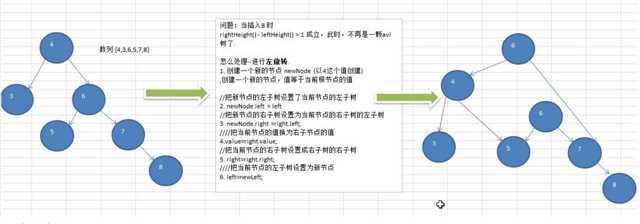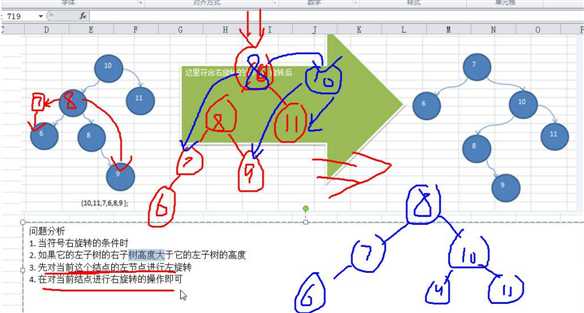标签:伸展树 原来 问题分析 ring 说明 判断 param ima lan
基本介绍:
1) 平衡二叉树也叫平衡 二叉搜索树(Self-balancing binary search tree)又被称为 AVL 树, 可以保证查询效率较高。
2) 具有以下特点:它是一 一 棵空树或 它的左右两个子树的高度差的绝对值不超过 1,并且 左右两个子树都是一棵平衡二叉树。平衡二叉树的常用实现方法有红黑树、AVL、替罪羊树、Treap、伸展树等。
3) 举例说明, 看看下面哪些 AVL 树, 为什么?

应用案例-单旋转(左旋转)
1) 要求: 给你一个数列,创建出对应的平衡二叉树.数列 {4,3,6,5,7,8}
2) 思路分析(示意图)

代码实现:
//左旋转方法
//左旋转方法
private void leftRotate() {
//创建新的结点,以当前根结点的值
Node newNode = new Node(value);
//把新的结点的左子树设置成当前结点的左子树
newNode.left = left;
//把新的结点的右子树设置成带你过去结点的右子树的左子树
newNode.right = right.left;
//把当前结点的值替换成右子结点的值
value = right.value;
//把当前结点的右子树设置成当前结点右子树的右子树
right = right.right;
//把当前结点的左子树(左子结点)设置成新的结点
left = newNode;
}
应用案例-单旋转(右旋转):
1) 要求: 给你一个数列,创建出对应的平衡二叉树.数列 {10,12, 8, 9, 7, 6}
2) 思路分析(示意图)

代码实现:
//右旋转
private void rightRotate() {
Node newNode = new Node(value);
newNode.right = right;
newNode.left = left.right;
value = left.value;
left = left.left;
right = newNode;
}
应用案例-双旋转:
前面的两个数列,进行单旋转(即一次旋转)就可以将非平衡二叉树转成平衡二叉树,但是在某些情况下,单旋转不能完成平衡二叉树的转换。比如数列
int[] arr = { 10, 11, 7, 6, 8, 9 }; 运行原来的代码可以看到,并没有转成 AVL 树.
int[] arr = {2,1,6,5,7,3}; // 运行原来的代码可以看到,并没有转成 AVL 树
问题分析:

解决思路分析
1. 当符号右旋转的条件时
2. 如果它的左子树的右子树高度大于它的左子树的高度
3. 先对当前这个结点的左节点进行左旋转
4. 在对当前结点进行右旋转的操作即可
完整代码:
package com.pierce.algorithm;
public class AVLTreeDemo {
public static void main(String[] args) {
//int[] arr = {4,3,6,5,7,8};
//int[] arr = { 10, 12, 8, 9, 7, 6 };
int[] arr = {10, 11, 7, 6, 8, 9};
//创建一个 AVLTree 对象
AVLTree avlTree = new AVLTree();
//添加结点
for (int i = 0; i < arr.length; i++) {
avlTree.add(new Node6(arr[i]));
}
//遍历
System.out.println("中序遍历");
avlTree.infixOrder();
System.out.println("在平衡处理~~");
System.out.println("树的高度=" + avlTree.getRoot().height()); //3
System.out.println("树的左子树高度=" + avlTree.getRoot().leftHeight()); // 2
System.out.println("树的右子树高度=" + avlTree.getRoot().rightHeight()); // 2
System.out.println("当前的根结点=" + avlTree.getRoot());//8
}
}
// 创建 AVLTree
class AVLTree {
private Node6 root;
public Node6 getRoot() {
return root;
}
// 查找要删除的结点
public Node6 search(int value) {
if (root == null) {
return null;
} else {
return root.search(value);
}
}
// 查找父结点
public Node6 searchParent(int value) {
if (root == null) {
return null;
} else {
return root.searchParent(value);
}
}
// 编写方法:
// 1. 返回的 以 Node6 为根结点的二叉排序树的最小结点的值
// 2. 删除 Node6 为根结点的二叉排序树的最小结点
/**
* @param Node6 传入的结点(当做二叉排序树的根结点)
* @return 返回的 以 Node6 为根结点的二叉排序树的最小结点的值
*/
public int delRightTreeMin(Node6 Node6) {
Node6 target = Node6;
// 循环的查找左子节点,就会找到最小值
while (target.left != null) {
target = target.left;
}
// 这时 target 就指向了最小结点
// 删除最小结点
delNode6(target.value);
return target.value;
}
// 删除结点
public void delNode6(int value) {
if (root == null) {
return;
} else {
// 1.需求先去找到要删除的结点 targetNode6
Node6 targetNode6 = search(value);
// 如果没有找到要删除的结点
if (targetNode6 == null) {
return;
}
// 如果我们发现当前这颗二叉排序树只有一个结点
if (root.left == null && root.right == null) {
root = null;
return;
}
// 去找到 targetNode6 的父结点
Node6 parent = searchParent(value);
// 如果要删除的结点是叶子结点
if (targetNode6.left == null && targetNode6.right == null) {
// 判断 targetNode6 是父结点的左子结点,还是右子结点
if (parent.left != null && parent.left.value == value) { // 是左子结点
parent.left = null;
} else if (parent.right != null && parent.right.value == value) {// 是由子结点
parent.right = null;
}
} else if (targetNode6.left != null && targetNode6.right != null) { // 删除有两颗子树的节点
int minVal = delRightTreeMin(targetNode6.right);
targetNode6.value = minVal;
} else { // 删除只有一颗子树的结点
// 如果要删除的结点有左子结点
if (targetNode6.left != null) {
if (parent != null) {
// 如果 targetNode6 是 parent 的左子结点
if (parent.left.value == value) {
parent.left = targetNode6.left;
} else { // targetNode6 是 parent 的右子结点
parent.right = targetNode6.left;
}
} else {
root = targetNode6.left;
}
} else { // 如果要删除的结点有右子结点
if (parent != null) {
// 如果 targetNode6 是 parent 的左子结点
if (parent.left.value == value) {
parent.left = targetNode6.right;
} else { // 如果 targetNode6 是 parent 的右子结点
parent.right = targetNode6.right;
}
} else {
root = targetNode6.right;
}
}
}
}
}
// 添加结点的方法
public void add(Node6 Node6) {
if (root == null) {
root = Node6;// 如果 root 为空则直接让 root 指向 Node6
} else {
root.add(Node6);
}
}
// 中序遍历
public void infixOrder() {
if (root != null) {
root.infixOrder();
} else {
System.out.println("二叉排序树为空,不能遍历");
}
}
}
// 创建 Node6 结点
class Node6 {
int value;
Node6 left;
Node6 right;
public Node6(int value) {
this.value = value;
}
// 返回左子树的高度
public int leftHeight() {
if (left == null) {
return 0;
}
return left.height();
}
// 返回右子树的高度
public int rightHeight() {
if (right == null) {
return 0;
}
return right.height();
}
// 返回 以该结点为根结点的树的高度
public int height() {
return Math.max(left == null ? 0 : left.height(), right == null ? 0 : right.height()) + 1;
}
//左旋转方法
private void leftRotate() {
//创建新的结点,以当前根结点的值
Node6 newNode6 = new Node6(value);
//把新的结点的左子树设置成当前结点的左子树
newNode6.left = left;
//把新的结点的右子树设置成带你过去结点的右子树的左子树
newNode6.right = right.left;
//把当前结点的值替换成右子结点的值
value = right.value;
//把当前结点的右子树设置成当前结点右子树的右子树
right = right.right;
//把当前结点的左子树(左子结点)设置成新的结点
left = newNode6;
}
//右旋转
private void rightRotate() {
Node6 newNode6 = new Node6(value);
newNode6.right = right;
newNode6.left = left.right;
value = left.value;
left = left.left;
right = newNode6;
}
// 查找要删除的结点
/**
* @param value 希望删除的结点的值
* @return 如果找到返回该结点,否则返回 null
*/
public Node6 search(int value) {
if (value == this.value) { // 找到就是该结点
return this;
} else if (value < this.value) {// 如果查找的值小于当前结点,向左子树递归查找
// 如果左子结点为空
if (this.left == null) {
return null;
}
return this.left.search(value);
} else { // 如果查找的值不小于当前结点,向右子树递归查找
if (this.right == null) {
return null;
}
return this.right.search(value);
}
}
// 查找要删除结点的父结点
/**
* @param value 要找到的结点的值
* @return 返回的是要删除的结点的父结点,如果没有就返回 null
*/
public Node6 searchParent(int value) {
// 如果当前结点就是要删除的结点的父结点,就返回
if ((this.left != null && this.left.value == value) || (this.right != null && this.right.value == value)) {
return this;
} else {
// 如果查找的值小于当前结点的值, 并且当前结点的左子结点不为空
if (value < this.value && this.left != null) {
return this.left.searchParent(value); // 向左子树递归查找
} else if (value >= this.value && this.right != null) {
return this.right.searchParent(value); // 向右子树递归查找
} else {
return null; // 没有找到父结点
}
}
}
@Override
public String toString() {
return "Node6 [value=" + value + "]";
}
// 添加结点的方法
// 递归的形式添加结点,注意需要满足二叉排序树的要求
public void add(Node6 Node6) {
if (Node6 == null) {
return;
}
// 判断传入的结点的值,和当前子树的根结点的值关系
if (Node6.value < this.value) {
// 如果当前结点左子结点为 null
if (this.left == null) {
this.left = Node6;
} else {
// 递归的向左子树添加
this.left.add(Node6);
}
} else { // 于 添加的结点的值大于 当前结点的值
if (this.right == null) {
this.right = Node6;
} else {
// 递归的向右子树添加
this.right.add(Node6);
}
}
// 当添加完一个结点后,如果: ( 右子树的高度- 左子树的高度) > 1 , 左旋转
if (rightHeight() - leftHeight() > 1) {
// 如果它的右子树的左子树的高度大于它的右子树的右子树的高度
if (right != null && right.leftHeight() > right.rightHeight()) {
// 先对右子结点进行右旋转
right.rightRotate();
// 然后在对当前结点进行左旋转
leftRotate(); // 左旋转..
} else {
// 直接进行左旋转即可
leftRotate();
}
return; // 必须要!!!
}
//果 当添加完一个结点后,如果 (度 左子树的高度 - 右子树的高度) > 1, 右旋转
if (leftHeight() - rightHeight() > 1) {
// 如果它的左子树的右子树高度大于它的左子树的高度
if (left != null && left.rightHeight() > left.leftHeight()) {
// 先对当前结点的左结点( 左子树)-> 左旋转
left.leftRotate();
// 再对当前结点进行右旋转
rightRotate();
} else {
// 直接进行右旋转即可
rightRotate();
}
}
}
// 中序遍历
public void infixOrder() {
if (this.left != null) {
this.left.infixOrder();
}
System.out.println(this);
if (this.right != null) {
this.right.infixOrder();
}
}
}
标签:伸展树 原来 问题分析 ring 说明 判断 param ima lan
原文地址:https://www.cnblogs.com/pierceming/p/12791105.html